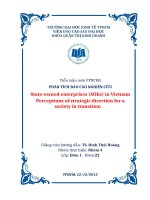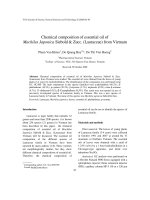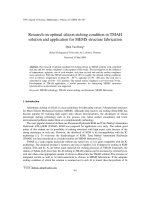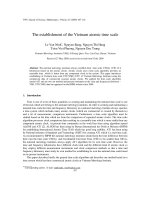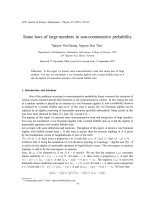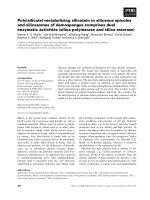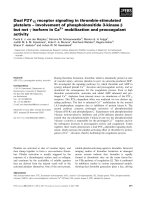Báo cáo " Diffusion behaviour of corrosive solution environments in carbon black filled modified polyethylene linings " doc
Bạn đang xem bản rút gọn của tài liệu. Xem và tải ngay bản đầy đủ của tài liệu tại đây (408.25 KB, 11 trang )
VNU Journal of Science, Mathematics - Physics 26 (2010) 71-81
Diffusion behaviour of corrosive solution environments in
carbon black filled modified polyethylene linings
Chau Van Dinh1,*, M. Kubouchi2
1
Department of Physical Engineering and Nano Technology
University of Technology and Engineering, VNU, 144 Xuan Thuy, Cau Giay, Hanoi, Vietnam
2
Department of Chemical Engineering, Graduate School of Science and Engineering
Tokyo Institute of Technology, 2-12-1, Ookayama, Meguro, Tokyo. 152-8552, Japan
Received 15 December 2009
Abstract. The diffusion behaviour of water and HCl solution at different temperatures and
concentrations into a modified polyethylene filled with carbon black used for lining is presented. It
has shown the predominant role of nature of environment and carbon black content. In the both
environments, an increase of environmental temperature increased the capacity of environmental
absorption and the diffusion rate. The lower sorption capacity was observed at 40 and 60 oC while
a higher at 80oC in the water. The two-stage diffusion appeared for the case of the corrosive
environment at 80oC. An increase of carbon black loading was increased both diffusion rate and
saturation values.
Diffusion of the environment into the polymer proposed by the following: environmental
molecules diffusing into the polymer matrix through porous system, were trapped by functional
groups on the carbon black surface and polymer molecule chain, and are immobilized. This
explains the increase of sorption capacity when increase carbon black loading.
Keywords: modified polyethylene composites, lining, diffusion, chemical degradation.
1. Introduction
The service life of polymeric lining/coating-iron/steel system is limited by degradation and
diffusion phenomenon. The polymeric lining/coating layer is required to have high resistance against
its working corrosive environment, low environmental diffusion rate, and high adhesion on substrate.
Polyethylene (PE) is considered as a good material for lining because of its high chemical resistance to
many corrosive environments [1]. For purpose of the adhesion improvement, PE used for
lining/coating was modified. This modification may effect property of PE i.e. it may change
degradation resistance or diffusion behaviour in comparison with those of the original PE.
Carbon black (CB) has excellent properties, such as heat, chemical and weather resistance, light
weight, and low thermal expansion [2-4]. It is widely used industrially as a deep black pigment for
polymeric materials, weathering proof filler in polymer industry, and other applications [3-7]. The use
of carbon black in PE lining beside as pigment additives, it may hinders the ultraviolet degradation.
However, it may effect diffusion behaviour of working solution environment into the lining layer.
______
*
Corresponding author. E-mail:
71
72
D.V. Chau, M. Kubouchi / VNU Journal of Science, Mathematics - Physics 26 (2010) 71-81
This paper presents role of carbon black loading on diffusion behaviour of water and hydrochloric
acid solution into a modified polyethylene (sPE) using for lining on steel.
2. Experiment
2.1. Material
A grade of linear-low-density polyethylene resin having density in range of 0.925 – 0.930 g/cm3
was used to form test pieces in this study. The resin was chemically modified to form a blend
polyethylene named as sPE. Due to limits on information sharing, further details of modification
process and the use of modified agent are not released. Mixtures of this blend polyethylene and carbon
black were performed in accordance with ratio of 2, 3, and 4 mass% of carbon black. Rectangular
sample sheets with thickness of 1.0 mm were made by hot compression molding method using these
mixtures. The test pieces having dimension of 60 x 25 mm were cut out from the prepared sample
sheets, then were dried up at 50oC for 72 hours to ensure that the remaining moisture was removed
before the immersion test was carried out.
Table 1. Materials used for investigation
Code
base polymer
sPE-2
LDPE
Composition of
modifier
5%
sPE-3
LDPE
5%
3%
sPE-4
LDPE
5%
4%
carbon black composition
2%
2.2. Immersion study
Immersion experiment was carried out by simply immersing the test pieces in water and 10, 20
mass% hydrochloric acid solutions. The test pieces were fixed in a polytetrafluoroethylene holder to
avoid contact surface each other, and immersed in separable flash bottles which filled with the test
solution, connecting to a condensing system. Temperatures of the environmental solution were
constantly set at 40, 60, and 80oC.
At interval time, the specimens were taken out, wiped by filter paper to remove attached solution
on their surfaces and weighed by a balance with 0.1 mg accuracy. A change in mass was measured
related to initial mass.
To characterize mode of the environmental diffusion, penetration pattern of chloride (Cl) element
into the specimens was observed by using energy dispersive X-ray spectroscopy (EDS) on cross
section of sample. Scanning Electronic Microscope (SEM) was also used to observe the morphology
of sample during immersion.
3. Results and discussion
The quantity of solution environment penetrating into the test polymer matrix as a function of time
has been determined. Figures 1.a; 1.b and 1.c give typical examples of plots of the absorbed amount
(Mt) of water, HCl 10 mass%, and HCl 20 mass% at 40, 60, and 80 oC versus immersion time for the
D.V. Chau, M. Kubouchi / VNU Journal of Science, Mathematics - Physics 26 (2010) 71-81
73
sPE-2, sPE-3, and sPE-4, respectively. From these curves, the environmental solution absorbed at
saturation (M∞) can be determined. Diffusion coefficient (D) was also calculated by following
equation, base on initial slope method if the diffusion is considered to be Fickian mode [8 -15]:
Mt
4
=
Dt
(1)
M∞ L π
In which, L is thickness of the test specimen and t is diffusion time.
3.1. Diffusion behaviour of water
Figure 1 shows weight change profiles of the polymers during immersion in the 40, 60, and 80 oC
water environment. Main characteristics of the diffusion are detailed in Table 2. It is clearly seen that
the sorption capacity of a polymer depends on its carbon black loading and temperature of the
environment. For a polymer, the uptake amount increased with increasing temperature, indicating of
the more entry of water molecules into the free volume space of the matrix polymer. The saturation
increased from 0.30, 0.32, and 0.42 % (at 40oC) to 2.08, 2.17, and 2.40 % (at 80oC) for the sPE-2, sPE3, and sPE-4, respectively. It is also note that a slight increase of the saturation value at 40oC to those
at 60oC was observed whereas a large amount of uptake (more than about 5 – 7 times) was observed at
80oC. This maybe attributed to significant change of physical state of the specimens at 0oC in
comparison to those at 40 and 60 oC.
Table 2. Diffusion characteristics in water
40oC
60oC
80oC
D
Mexp.∞
D
Mexp.∞
D
Mexp.∞
[10-14 m2s-1]
[%]
[10-14 m2s-1]
[%]
[10-14 m2s-1]
[%]
sPE-2
4.21
0.30
4.44
0.50
1.09
2.08
sPE-3
4.81
0.32
4.91
0.57
1.12
2.17
sPE-4
5.44
0.42
5.51
0.63
1.13
2.40
Polymer
By contrast, as far as the saturation values are obtained, the maximal quantity absorbed by the
polymers seem to be additive. Consideration of polymer composition (modified PE and carbon black),
the maximal quantity of water absorbed can be calculated using the following relationship:
modified PE
carbon
polymer
M∞
+ x2 M ∞ black
(2)
calc. = x1M ∞
in which, x1, and x2 being the weight fraction of the modified PE and carbon black composition,
respectively. The experimental values and calculated values in Table 3 confirm this hypothesis of
additivity. The higher of experimental value than the calculated value may be attributed to synergic
effect (establishment of new pores or free volume) of carbon black and modified PE when these
constituents formed the polymers. An evidence of pore observation using SEM in Figure 2 may
confirm this explanation.
An interesting point was found out that the mean diffusivity is higher at 60oC than at 40oC,
however, it is lowest at 80oC (see Table 2). A possible explanation for this phenomenon is that effect
of thermal relaxation of polymer chains at 60oC improved penetration of water molecules into the
polymer matrix than those at 40oC, however, a strong relaxation of these chains at 80oC may lead to
appear an internal stress that reduce penetrating rate of water molecules.
74
D.V. Chau, M. Kubouchi / VNU Journal of Science, Mathematics - Physics 26 (2010) 71-81
0.8
0.6
4 % carbon black loading
0.6
Weight change, %
Weight change, %
0.7
3 % carbon black loading
2 % carbon black loading
0.5
0.4
0.3
(b)
0.5
0.4
0.3
0.2
4 % carbon black loading
0.2
(a)
0.1
3 % carbon black loading
2 % carbon black loading
0.1
0.0
0.0
0
0
10
20
30
40
50
Square root of time, (h0.5)
60
10
20
70
30
40
50
60
70
Square root of time, (h0.5 )
2.6
2.4
4 % carbon black loading
2.2
3 % carbon black loading
2 % carbon black loading
Weight change, %
2.0
1.8
1.6
1.4
1.2
1.0
(c)
0.8
0.6
0.4
0.2
0.0
0
10
20
30
40
50
60
70
80
Square root of time, (h0.5 )
Fig. 1. Diffusion behaviour in water: a – at 40oC; b – at 60oC; and c – at 80oC.
Diffusion data in Table 2 also illustrated influence of carbon black loading on diffusion behaviour
of water into the polymers. As seen in Table 2, an increase of carbon black loading leads to an
increase of M∞ and D. However, the significance of carbon loading on diffusion behaviour is minor
in comparison with those of temperature. The effect of carbon black constituent on mechanism of
penetration of water into the polymers would be proposed as the following: water diffuses through the
polymer matrix and is irreversibly trapped by carbon black particles until all oxygenated sites are
saturated [16-18]. The water fixed on surface of carbon black particles is thus immobilized and do not
participate in further diffusion [16]. Considerating of this explanation, it would hypothesize that if a
polymer having carbon black loading content higher than over an criterion will lead to low-down
diffusion rate.
Table 3. Saturation absorption in water
40oC
Polymer
Modified PE
Carbon black
sPE-2
sPE-3
sPE-4
calc.
M ∞
[%]
0.26
2.26
0.30
0.32
0.34
60oC
exp.
M ∞
[%]
0.30
0.32
0.42
calc.
M ∞
[%]
0.36
7.36
0.5
0.57
0.64
80oC
exp.
M ∞
[%]
0.50
0.57
0.65
calc.
M ∞
[%]
1.90
10.90
2.08
2.17
2.26
Mexp.∞
[%]
2.08
2.17
2.40
75
D.V. Chau, M. Kubouchi / VNU Journal of Science, Mathematics - Physics 26 (2010) 71-81
a
b
Pores
c
Fig. 2. SEM images of laminated polymer: a- sPE-2; b-sPE-3; and c-sPE-4.
3.2. Diffusion behaviour of corrosive solution environment
Hydrochloric acid solution is considered to be corrosive environment in this study. Figure 3, 4
show the weight change profiles of the specimens during immersion. The diffusion data is listed in
Table 4. It can be seen that nature of environment and filled carbon black content influenced on
diffusion behaviour.
Significance of nature of environment was confirmed again in case of the corrosive environments.
For instance, similar to the case of water, the Fickian diffusion was also observed at 40 and 60oC.
However, an interest was found that the two-stage diffusion appeared at 80oC. The two-stage diffusion
appeared in the corrosive environment at high temperature (80oC) indicates that there was of a
synergic effect of thermal and corrosive component. Chloride mapping analysis using EDS showed
that a few chloride elements were observed for first saturation while they were much for second
saturation (see Figure 5). Therefore, it would be said that water component diffused predominantly
during first stage whereas diffusion of chloride element took over during the second stage. Finding of
chemical bond of Cl with functional group of the modified polymer [19] may affirm this hypothesis.
76
D.V. Chau, M. Kubouchi / VNU Journal of Science, Mathematics - Physics 26 (2010) 71-81
0.5
1.0
0.9
0.8
(a)
Weight change, %
Weight change, %
0.4
0.3
0.2
0.6
0.5
0.4
0.3
4 % carbon black loading
3 % carbon black loading
2 % carbon black loading
0.1
(b)
0.7
4 % carbon black loading
0.2
3 % carbon black loading
2 % carbon black loading
0.1
0.0
0.0
0
10
20
30
40
50
Square root of time, (h0.5)
60
0
70
10
20
30
40
50
60
70
Square root of time, (h0.5)
2.0
4 % carbon black loading
1.6
Weight change, %
1.8
3 % carbon black loading
2 % carbon black loading
1.4
1.2
1.0
0.8
0.6
(c)
0.4
0.2
0.0
0
10
20
30
40
50
60
70
80
Square root of time, (h0.5)
Fig. 3. Diffusion behaviour in HCl 10 mass% solution: a – at 40oC; b – at 60oC; and c – at 80oC.
Table 4. Diffusion characteristics in corrosive environment
HCl 10 mass%
o
Polyme
r
o
40 C
Mexp.∞
D
80oC
60 C
1st stage
Mexp.∞
D
exp.
2nd stage
D
Mexp.∞
-14
2 -1
[10 m s ]
[%]
3.90
1.44
0.59
D
[10-14 m2s-1]
8.10
M ∞
[%]
0.67
3.78
0.68
8.11
0.71
3.34
1.58
4.78
0.77
8.92
0.79
4.96
1.63
[10-14 m2s-1]
[%]
[10-14 m2s-1]
[%]
sPE-2
3.19
0.30
3.49
sPE-3
3.41
0.33
sPE-4
4.39
0.38
HCl 20 mass%
o
o
40 C
Polymer
80oC
60 C
D
Mexp.∞
D
[10-14 m2s-1]
[%]
[10-14 m2s-1]
[%]
sPE-2
2.65
0.55
3.96
sPE-3
3.05
0.61
sPE-4
3.46
0.69
1st stage
Mexp.∞
2nd satge
D
Mexp.∞
-14
2 -1
[10 m s ]
[%]
6.88
2.21
0.96
D
[10 m2s-1]
25.59
Mexp.∞
[%]
0.92
4.07
1.05
23.85
1.04
19.59
2.49
4.45
1.15
22.29
1.14
22.29
2.70
-14
77
D.V. Chau, M. Kubouchi / VNU Journal of Science, Mathematics - Physics 26 (2010) 71-81
0.8
1.4
0.7
1.2
(a)
(b)
Weight change, %
Weight change, %
0.6
0.5
0.4
0.3
4 % carbon black loading
0.2
10
20
30
40
50
Square root of time, (h0.5 )
60
0.6
4 % carbon black loading
3 % carbon black loading
2 % carbon black loading
0.2
0.0
0
0.8
0.4
3 % carbon black loading
2 % carbon black loading
0.1
1.0
70
0.0
0
10
20
30
40
50
60
70
Square root of time, (h0.5)
3.0
2.7
Weight change, %
2.4
(c)
2.1
1.8
1.5
1.2
0.9
4 % carbon black loading
0.6
3 % carbon black loading
2 % carbon black loading
0.3
0.0
0
10
20
30
40
50
Square root of time, (h 0.5)
60
70
Fig. 4. Diffusion behaviour in HCl 20 mass% solution: a – at 40oC; b – at 60oC; and c – at 80oC.
The sorption capacity, diffusion rate is considerably influenced by the concentration and
temperature of the exposed environment. As shown in Table 4, for the same HCl concentration
solution, Mexp∞ and D increased with increasing temperature, similar tendency to those for the case
exposed in water, whereas at the same temperature, the only sorption capacity increased with
increasing HCl concentration while diffusion rate changed considerably with the HCl concentration. It
also notes that the sorption capacity of the polymers exposed to HCl 10 mass% at 40 and 60 oC was a
little higher than those to water at 40 and 60 oC, however, it was about double for the polymers
exposed to HCl 20 mass% at the same temperature. Estimation of specific density of HCl solution was
showed that it is about 4.7 and 9.8 % (corresponding to HCl 10 mass% and HCl 20 mass% solution)
higher than those of water. Therefore, the little higher sorption capacity for samples exposed to the
HCl 10 mass% solution at 40 and 60 oC maybe attributed to increase of the specific density. Beside a
minor influence of the specific density, significant increase of sorption capacity when samples
78
D.V. Chau, M. Kubouchi / VNU Journal of Science, Mathematics - Physics 26 (2010) 71-81
exposed to HCl 20 mass% is considered by a change of micro structure of samples. SEM analysis
showed that more number of pores was observed for saturated sample. Figure 6 is an example
confirming this observation. Establishment of new pores during immersion may result from a reaction
of polymer’s polar group with HCl component [17].
Table 5. Calculated and experimental sorption capacity in corrosive environment
HCl 10 mass%
o
o
40 C
Polymer
Mcalc.∞
80oC
60 C
Mexp.∞
Mcalc.∞
Mexp.∞
1st stage
M ∞
Mexp.∞
[%]
[%]
2nd stage
M ∞
Mexp.∞
[%]
[%]
calc.
calc.
[%]
[%]
[%]
[%]
0.24
-
0.41
-
0.59
-
1.16
-
3.24
-
9.41
-
4.59
-
15.16
-
0.30
0.30
0.59
0.59
0.67
0.67
1.44
1.44
sPE-3
0.33
0.33
0.68
0.68
0.71
0.71
1.58
1.58
sPE-4
0.36
0.38
0.77
0.77
0.75
0.79
1.72
1.63
Modified
PE
Carbon
black
sPE-2
HCl 20 mass%
o
o
40 C
Polymer
Mcalc.∞
80oC
60 C
Mexp.∞
Mcalc.∞
Mexp.∞
1st stage
M ∞
Mexp.∞
[%]
[%]
calc.
2nd satge
M ∞
Mexp.∞
[%]
[%]
calc.
[%]
[%]
[%]
[%]
0.43
-
0.78
-
0.68
-
1.65
-
Modified
PE
Carbon
black
sPE-2
6.43
-
9.78
-
12.68
-
29.65
-
0.55
0.55
0.96
0.96
0.92
0.92
2.21
2.21
sPE-3
0.61
0.61
1.05
1.05
1.04
1.04
2.49
2.49
sPE-4
0.67
0.69
1.14
1.15
1.16
1.14
2.77
2.70
Carbon black loading was also influenced on diffusion characteristics. The diffusion rate and
saturation value increased with increasing carbon black content. As mentioned in previous part, an
increase of carbon black content leads to the increase of porous density or free volume of polymer
resulted therefore in increase value of M∞ and D. An another considering reason explaining the
influence of carbon black content is that the more carbon black content leads to much number of
environmental molecules trapped by the carbon black particle led to an increase of M∞. However, the
diffusion rate was lower than those exposed to water. This observation would be explained as the
following: water and HCl molecules diffuse competitively through the polymer matrix and is
irreversibly trapped by the carbon black particles until all oxygenated sites are saturated. The
competition between these two components resulted in lower-down process. However, the diffusion
and trapping corresponding to water component was predominant over HCl component. The chloride
mapping analysis during immersion confirmed this hypothesis. Figure 5 is an example of the chloride
mapping analysis result.
D.V. Chau, M. Kubouchi / VNU Journal of Science, Mathematics - Physics 26 (2010) 71-81
A1
A2
B1
B2
C1
C2
79
A3
B2
C3
Fig. 5. EDS chloride mapping of samples: A 1-3 – sPE-2; B1-3 – sPE-3; and C1-3 – sPE-4 for 144, 480, and
2345 h immersion respectively in the 80oC HCl 20 mass% solution.
With application of the same law of additivity used previously for the case of water environment
to the case of corrosive environment, the calculated saturation value was obtained and detailed in
Table 5.
80
D.V. Chau, M. Kubouchi / VNU Journal of Science, Mathematics - Physics 26 (2010) 71-81
A1
A2
B1
B2
C2
C1
A3
B3
C3
Fig. 6. SEM images of polymer: A 1-3 – sPE-2; B1-3 – sPE-3; and C1-3 – sPE-4 for 0,
480, and 2345 h immersion respectively in the 80oC HCl 20 mass% solution.
4. Conclusion
The study of the diffusion behaviour of water and corrosive solution environment in a carbon
black filled modified polyethylene using for lining application has shown the predominant role of
nature of environment and carbon black content. In the both environments, an increase of
environmental temperature increased the capacity of environmental absorption and the diffusion rate.
Sorption capacity of polymer in corrosive environment at low temperature (40 and 60 oC) was higher
D.V. Chau, M. Kubouchi / VNU Journal of Science, Mathematics - Physics 26 (2010) 71-81
81
than those in the water while it was lower at 80oC. The two-stage diffusion appeared for the case of the
corrosive environment at 80oC. An increase of carbon black loading was increased both diffusion rate
and saturation values.
Diffusion of the environment into the polymer is proposed by the following: environmental
molecules diffusing into the polymer matrix through porous system, were trapped by functional groups
on the carbon black surface and polymer molecule chain, and are immobilized. This explains the
increase of sorption capacity when increase carbon black loading.
The results of this study suggest that in order to improve the resistance of water and HCl solution
penetration, the modified polyethylene should mix with carbon black at low content. The working
temperature for these polymer linings in these environments should not be exceeded over 60oC.
References
[1] B. Bar-on, H. Shigemoto, M. Matsumoto, W. Hinterbauer, The Japanese Experience and a European
Challenge Two-Layer Polyethylene Coatings System for Steel Pipes. In Proc. 12th Int. Conf. Pipeline
Protection. BR Group: Paris, France, Nov. 4-6 (1997) 69.
[2] N. Tsubokawa, Functionalization of Carbon Black by Surface Grafting of Polymers. Prog. Polym. Sci.,
17 (1992) 417.
[3] J.B. Donnet, A. Voet, In Carbon Black, Physics, Chemistry, and Elastomer Reinforcement; Marcel
Dekker: New York, 1976.
[4] D.F. Twiss, The Rubber Manufacturers' Handbook: Tables and Formule. J. Soc. Chem. Ind. , 44 (1925)
539.
[5] G. Kraus, Reinforcement of elastomers by carbon black Adv. Polym. Sci., 8 (1971) 155.
[6] C.M. Blow, Polymer/particulate filler interaction—the bound rubber phenomena. Polymer., 14 (1973)
309.
[7] E.M. Dannenberg, Bound rubber and carbon black reinforcement. Rubber Chem. Technol., 59 (1986)
512.
[8] T. Alfey, E.F. Gurnee, W.G Lloyd, Diffusion in glassy polymers. J. Polym. Sci. Part C, 12 (1966) 249.
[9] J. Crank, The Mathematics of Diffusion; Oxford university press: Oxford, 1956.
[10] D. Vesely, Molecular sorption mechanism of solvent diffusion in polymers. Polymer. 42 (2001) 4417.
[11] D. Vesely, The rate of solvent diffusion in amorphous polymers. In Macromol. Symp., 138 (1999) 215.
[12] N.L. Thomas, A.H. Windle, A theory of case II diffusion. Polymer. 23 (1982) 529.
[13] P. Nogueira, C. Ramirez, A. Torres, M.J. Abad, J. Cano, J. Lopez, Effect of water sorption on the
structure and mechanical properties of an epoxy resin system. J. Polym. Sci., 80 (2001) 74.
[14] H.L. Frisch, Sorption and transport in glassy polymers-a review Polym. Eng. and Sci., 20 (1980) 2.
[15] Y. Dutheillet, M. Mantle, D. Vesely, L. Gladden, Diffusion of water–acetic acid mixtures in epoxy, J.
Polym. Sci. Part B: Polymer Physics., 37 (1999) 3328.
[16] J.Schultz, E. Papirer, C. Jacquemart, Mechanism of diffusion of water in carbon black filled polymers.
Eur. Polym. J., 22 (1986) 499.
[17] W.R. Vieth, J.M. Howell, J.H. Hsieh, Dual sorption theory. J. Membrane Sci., 1 (1976) 177.
[18] J.A. Barrie, In Diffusion in Polymer, ed. J.Crank, G.S. Park, Academic Press: U.K. (1968) 303.
[19] C.V. Dinh, M. Kubouchi, T. Sakai, K. Tsuda, R. Kobayashi, Study on Degradation of Different Types of
Polyethylene Exposed to Hydrochloric Acid Solution. In Proc. 54th Japan Conf. Material and
Environments. Japan Society of Corrosion Engineering [JSCE]: Hiroshima, Japan, (Oct. 31, 2007) 65.
